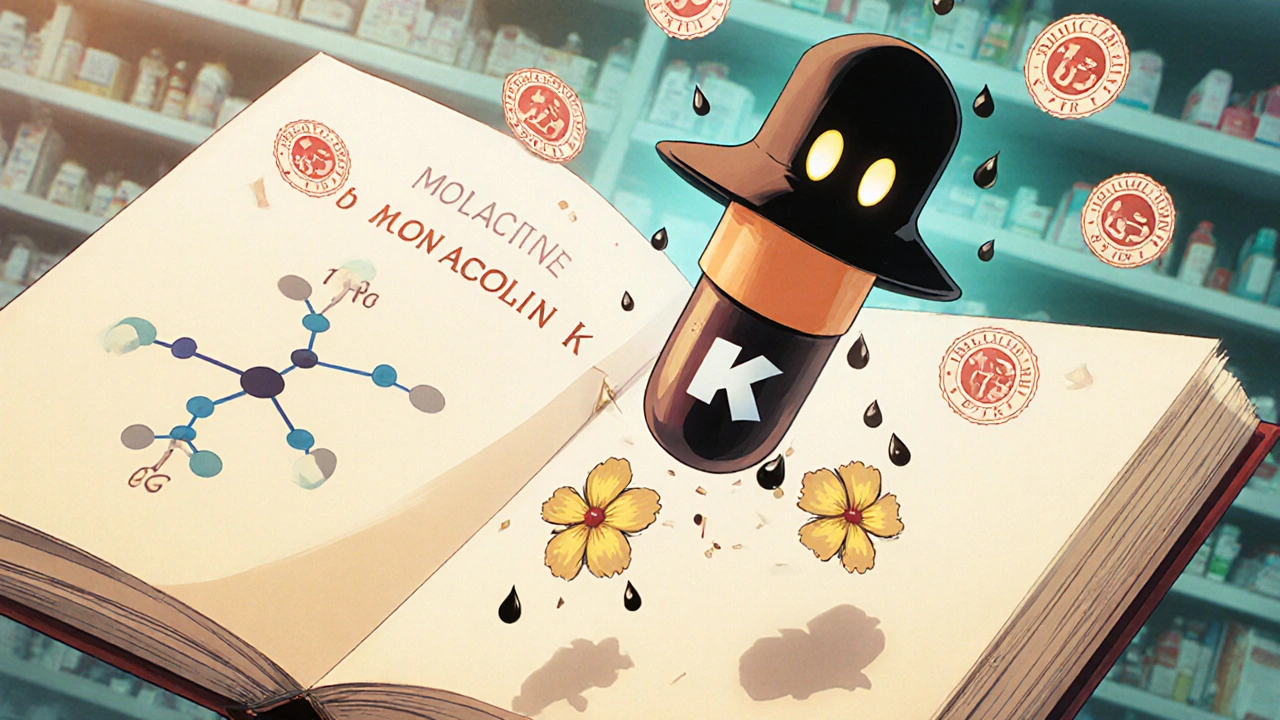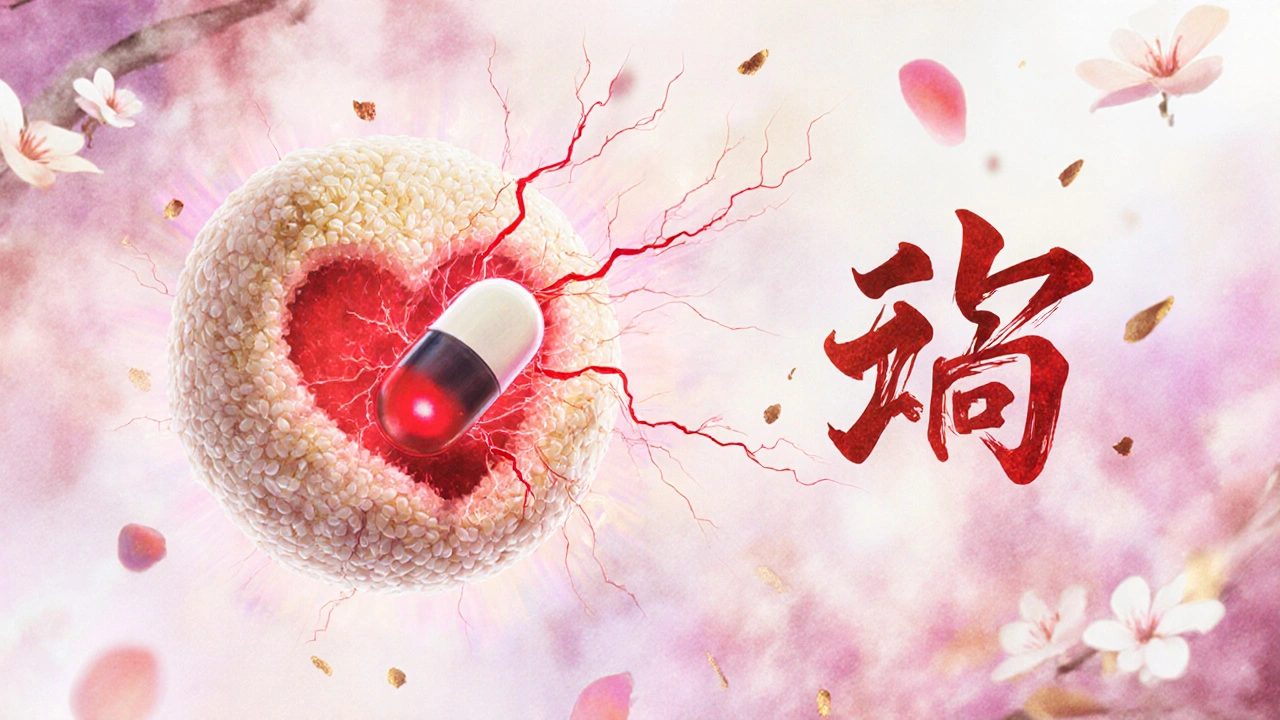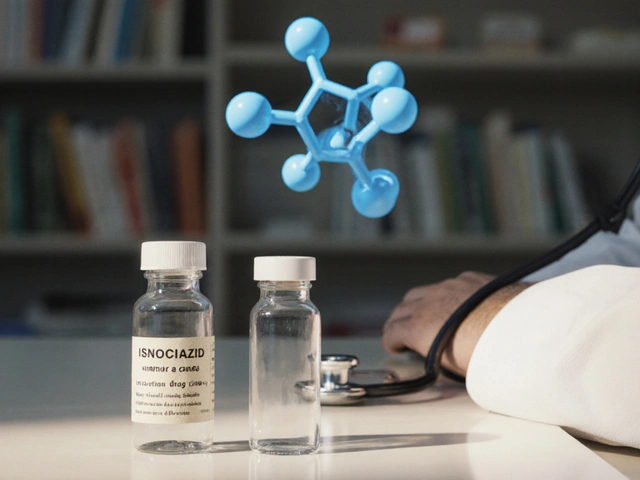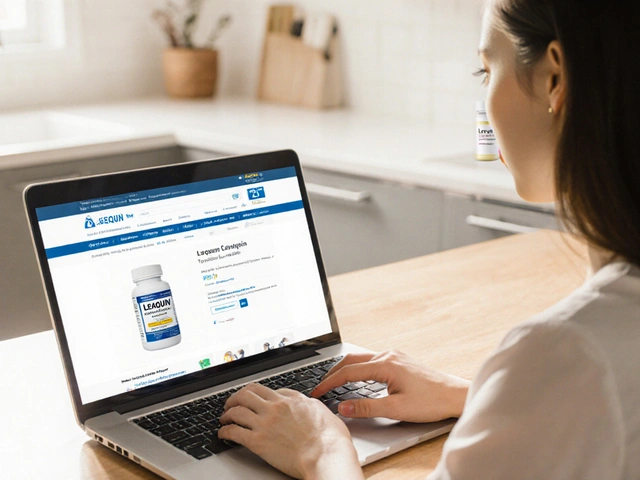Statin & Red Yeast Rice Risk Calculator
Calculate Your Risk
This calculator estimates your risk of muscle damage when combining statins and red yeast rice supplements. Based on FDA and Mayo Clinic data.
Many people turn to red yeast rice hoping to lower their cholesterol without prescription drugs. It’s marketed as a "natural" alternative, and for some, it works. But here’s the problem: if you’re already taking a statin, adding red yeast rice isn’t just redundant-it’s risky. You’re essentially doubling down on the same medicine, and that can land you in the hospital.
What Is Red Yeast Rice, Really?
Red yeast rice isn’t some exotic spice. It’s rice fermented with a mold called Monascus purpureus a fungus used in traditional Chinese medicine for centuries to aid digestion and circulation. The real story, though, starts in 1979, when a Japanese scientist discovered that one compound in this fermented rice-monacolin K-is chemically identical to lovastatin, the first statin drug ever made.That means red yeast rice doesn’t just "help" cholesterol-it actively blocks the same enzyme in your liver that statins target: HMG-CoA reductase. This enzyme is responsible for making cholesterol. Block it, and your LDL (bad cholesterol) drops. That’s why red yeast rice can lower LDL by 20-30% in clinical studies. Sounds great, right? Until you realize: you’re already doing that with a statin.
The Hidden Danger: Identical Drugs, Uncontrolled Doses
Prescription statins come with exact dosages: 10 mg, 20 mg, 40 mg. You know what you’re getting. Red yeast rice? Not even close.A 2022 ConsumerLab.com analysis found only 30% of red yeast rice supplements matched their label claims. Some had zero monacolin K. Others had up to 34 mg per gram-far more than a typical statin dose. One capsule might give you 3 mg of monacolin K. Another might give you 12 mg. No one knows until they test it.
And here’s the kicker: the FDA has issued over a dozen warning letters since 2008 to manufacturers for selling red yeast rice as an unapproved drug. Why? Because if it contains monacolin K, it’s not a supplement-it’s a pharmaceutical. But because of a loophole in the 1994 Dietary Supplement Health and Education Act, these products stay on shelves until proven dangerous.
Why Combining Them Is a Medical Emergency
When you take a statin and red yeast rice together, you’re stacking two HMG-CoA reductase inhibitors. That’s like turning up the volume on the same song with two speakers. The result? Muscle damage.Myopathy-muscle pain and weakness-is common with statins alone. But when combined with red yeast rice, the risk jumps 3.7 times, according to the Mayo Clinic. In severe cases, it becomes rhabdomyolysis: muscle tissue breaks down, floods your bloodstream with toxins, and can shut down your kidneys. The FDA’s adverse event database shows 127 documented cases of this between 2018 and 2022 involving both red yeast rice and statins.
One Reddit user, 'CardioWarrior99', posted about being hospitalized after taking 1,200 mg of red yeast rice daily while on 20 mg of atorvastatin. His creatine kinase (CK) levels hit 18,500 U/L. Normal is under 200. He needed IV fluids and a week in the hospital. He said, "My doctor told me I was lucky I didn’t lose a leg."

Who Should Even Consider Red Yeast Rice?
The only scenario where red yeast rice makes sense is if you can’t tolerate statins. About 7-29% of people on statins develop muscle pain or other side effects. For them, red yeast rice might be an option-if used alone, under supervision.A 2017 study found 60% of statin-intolerant patients could tolerate 1,800 mg of red yeast rice daily (roughly 3 mg monacolin K), with LDL dropping 25-30%. But that’s only if:
- You’re not taking any statin
- You use a USP-verified product (only 15% of the market meets this standard)
- You get baseline blood tests for liver enzymes and CK
- You avoid grapefruit juice, certain antibiotics, and other CYP3A4 inhibitors
Even then, you need to retest your blood after 3 months. And you must tell every doctor you see-because most don’t ask about supplements.
What About Other Cholesterol Options?
If you’re statin-intolerant, red yeast rice isn’t your only bet. There are FDA-approved alternatives with proven safety profiles:- Ezetimibe a pill that blocks cholesterol absorption in the gut, often combined with low-dose statins
- PCSK9 inhibitors injectable drugs that slash LDL by 50-60%, used for high-risk patients
- Bempedoic acid a newer oral drug that works in the liver, with lower muscle side effect risk
Yes, some cost more. PCSK9 inhibitors run over $300 a month. But they’re regulated, predictable, and backed by decades of research. Red yeast rice? You’re gambling with unverified doses and possible contamination.
The Contamination Risk You’re Not Hearing About
Red yeast rice isn’t just inconsistent-it’s often contaminated. The mold that makes monacolin K can also produce citrinin, a kidney-toxic mycotoxin. The European Food Safety Authority found it in 25-30% of commercial products. Long-term exposure can damage your kidneys, even if you don’t feel symptoms right away.Since 2023, the FDA has issued new warnings about citrinin. Some brands now test for it. But unless you see "USP Verified" on the label, you have no guarantee. And even USP doesn’t test every batch.

What Doctors Really Think
The American Heart Association, the American College of Cardiology, and the Mayo Clinic all say: don’t combine red yeast rice with statins. Period.Dr. JoAnn Manson from Harvard put it bluntly in JAMA Internal Medicine: "The variable monacolin content makes red yeast rice pharmacologically unpredictable compared to regulated pharmaceuticals." Dr. Michael Blaha at Johns Hopkins says combining them "increases the risk of myopathy exponentially."
Some practitioners, like Dr. David Heber from UCLA, argue that low-dose, standardized red yeast rice can be safe under supervision. But even he doesn’t recommend mixing it with statins. The medical consensus is clear: avoid the combo.
What to Do If You’re Already Taking Both
If you’re currently taking red yeast rice and a statin, stop the supplement immediately. Don’t wait for symptoms. Muscle damage can happen quietly-no pain at first, then sudden collapse.Call your doctor. Get a blood test for:
- CK (creatine kinase)-to check for muscle breakdown
- ALT and AST-liver enzymes
- Lipid panel-see if your cholesterol is still under control
If your CK is above 500 U/L, you need medical attention. If it’s over 1,000, you’re at risk for kidney failure.
Then, talk about alternatives. Maybe a lower-dose statin. Maybe ezetimibe. Maybe lifestyle changes: more fiber, more walking, less saturated fat. Red yeast rice isn’t the only path to lower cholesterol.
Bottom Line: Natural Doesn’t Mean Safe
Red yeast rice isn’t evil. For some, it’s a lifeline. But when mixed with statins, it becomes a ticking time bomb. The same active ingredient. The same mechanism. The same risks-only amplified.Don’t assume "natural" means harmless. Don’t assume your supplement is safe just because it’s on a shelf. And don’t take it with a statin unless your doctor has explicitly told you to-and even then, they’d be going against every major medical guideline.
If you’re trying to avoid statins, talk to your doctor about approved alternatives. If you’re already on one, skip the supplement. Your muscles, your kidneys, and your future self will thank you.
Can I take red yeast rice instead of a statin?
Yes, but only if you’re statin-intolerant and under medical supervision. Red yeast rice can lower LDL by 20-30%, similar to low-dose statins. But you must use a USP-verified product, avoid grapefruit juice, and get regular blood tests. Never switch without talking to your doctor.
How much monacolin K is in red yeast rice?
It varies wildly-from undetectable to over 30 mg per gram. Most supplements contain 3-10 mg per daily dose. That’s equivalent to 10-20 mg of lovastatin. But since labels are often wrong, you can’t trust the number on the bottle. Only USP-verified products offer reliable dosing.
Is red yeast rice FDA-approved?
No. The FDA considers red yeast rice containing monacolin K to be an unapproved drug. They’ve issued over a dozen warning letters to manufacturers since 2008. It’s sold as a supplement because of a legal loophole, not because it’s been proven safe or effective by pharmaceutical standards.
What are the side effects of red yeast rice?
Same as statins: muscle pain, weakness, liver enzyme elevation, and rare but serious rhabdomyolysis. It can also cause digestive upset. Contamination with citrinin-a kidney toxin-is common in non-verified products. Always get blood tests before and after starting.
Can I take red yeast rice with other supplements?
Avoid combining it with grapefruit juice, niacin, or any supplement that affects the CYP3A4 liver enzyme (like St. John’s wort or high-dose vitamin D). These can increase blood levels of monacolin K and raise your risk of side effects. Always tell your doctor about everything you’re taking.








8 Comments
Neoma Geoghegan
November 24, 2025 AT 09:37Statins + red yeast rice = medical roulette. Don't be that person. Stop the supplement now.
Bartholemy Tuite
November 25, 2025 AT 15:09Man i used to swear by red yeast rice till i read this. Thought it was just 'natural' magic. Turns out its just statin in a fancy bag with no quality control. My cousin ended up in the ER last year after mixing it with simvastatin. CK levels through the roof. Docs were like 'what the hell did you take?' He didn't even know it was the same drug. Wild how we trust supplements more than pharma. The FDA warnings? Most folks don't even check. Label says 'natural' and they're good to go. We need better labeling or outright bans. This isn't herbal tea its a hidden drug.
Sam Jepsen
November 27, 2025 AT 00:33Big shoutout to the author for breaking this down so clearly. So many people think 'natural' = safe. Nope. Natural can be deadly. I work in pharmacy and see this combo all the time. People come in asking why their muscles hurt so bad. They're on atorvastatin and popping red yeast rice like candy. They think it's 'boosting' the effect. It's not boosting. It's overloading. The citrinin risk? Most don't even know that's a thing. USP verification is the bare minimum. If it doesn't say USP? Don't touch it. And yeah, ezetimibe and bempedoic acid are way better options if statins don't sit right. Your muscles will thank you.
Yvonne Franklin
November 27, 2025 AT 06:29My dad took red yeast rice for 2 years. Never told his cardiologist. His ALT spiked to 120. He thought it was 'just liver fatigue'. We found out after a routine blood panel. He stopped immediately. No hospitalization but he had fatigue for months. The inconsistency is terrifying. One bottle zero monacolin K. The next 18 mg. No way to know. If you're going to use it, get USP. Get baseline labs. Tell every doctor. But honestly? Just use the real medicine. It's cheaper, regulated, and your doctor knows exactly what they're managing.
Melvina Zelee
November 28, 2025 AT 17:48It's wild how we treat supplements like they're harmless while prescription meds are the villains. But the science doesn't care about our feelings. Monacolin K is monacolin K whether it's in a capsule from a Chinese farm or a pill made by Pfizer. The body doesn't know the difference. The real issue is transparency. If red yeast rice had to list monacolin K dosage like a drug, maybe fewer people would mix it. But the 1994 loophole lets companies hide behind 'dietary supplement' while selling pharmaceuticals. We need to close that gap. Natural doesn't mean gentle. It just means unregulated. And that's dangerous.
ann smith
November 30, 2025 AT 16:04Thank you for this. 🙏 I've been telling my clients for years not to mix this stuff. So many think 'if a little is good, more is better'. Nope. The muscle damage can sneak up on you. No pain at first. Then boom. Kidney failure. I'm so glad you included the CK levels and what to do if you're already taking both. Please, if you're reading this and you're on statins - stop the red yeast rice. Talk to your doctor. There are safer, science-backed options. Your future self will be grateful. 💙
Daniel Jean-Baptiste
December 1, 2025 AT 04:59Im glad someone finally laid this out plain. I used to take red yeast rice because my doc said statins gave me cramps. But i didnt know how sketchy the dosing was. Found out later my bottle had 12mg monacolin K. Thats like a full dose of lovastatin. I stopped. Went to ezetimibe. No issues. Also never knew about citrinin. That freaks me out. My kidneys feel fine but still. I always thought supplements were safer. Turns out theyre just less monitored. Big lesson learned. Always check for USP. Always tell your doc. Always get bloodwork. And dont mix with statins. Ever.
Ravi Kumar Gupta
December 1, 2025 AT 15:50In India we use red yeast rice for centuries. But we also know: don't mix it with anything. We don't call it 'supplement'. We call it medicine. And medicine needs respect. Your body doesn't care if it's from a lab or a village pot. Monacolin K is monacolin K. The FDA is right. This isn't turmeric. This is a potent drug. And when you combine it with statins? You're playing with fire. My uncle had rhabdo. Lost 30% muscle mass. Now he walks with a cane. Don't be him. Stop the combo. Now. Your kidneys are not a gamble.